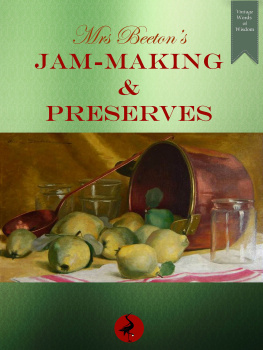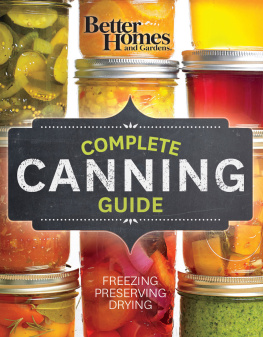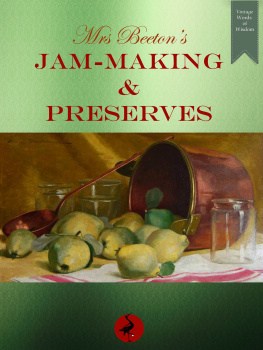ANCHOR BOOKS EDITION, SEPTEMBER 2011
Copyright 1972, 1975, 1999 by The Foxfire Fund, Inc.
All rights reserved. Published in the United States by Anchor Books, a division of Random House, Inc., New York.
Anchor Books and colophon are registered trademarks of Random House, Inc.
Preserving Vegetables and Fruit originally appeared in The Foxfire Book, 1972 by Brooks Eliot Wigginton. Reprinted by permission of Random House, Inc.
Apple Butter and Sorghum originally appeared in Foxfire 3, 1975 by The Foxfire Fund, Inc. Reprinted by permission of Random House, Inc.
Preserving and Cooking Food originally appeared in Foxfire 11, 1999 by The Foxfire Fund, Inc. Reprinted by permission of Random House, Inc.
eISBN: 978-0-307-94822-9
v3.1
Table of Contents
A NOTE ABOUT THE FOXFIRE AMERICANA LIBRARY SERIES
For almost half a century, high school students in the Foxfire program in Rabun County, Georgia, have collected oral histories of their elders from the southern Appalachian region in an attempt to preserve a part of the rapidly vanishing heritage and dialect. The Foxfire Fund, Inc., has brought that philosophy of simple living to millions of readers, starting with the bestselling success of The Foxfire Book in the early 1970s. Their series of fifteen books and counting has taught creative self-sufficiency and has preserved the stories, crafts, and customs of the unique Appalachian culture for future generations.
Traditionally, books in the Foxfire series have included a little something for everyone in each and every volume. For the first time ever, through the creation of The Foxfire Americana Library, this forty-five-year collection of knowledge has been organized by subject. Whether down-home recipes or simple tips for both your household and garden, each book holds a wealth of tried-and-true information, all passed down by unforgettable people with unforgettable voices.
PRESERVING AND COOKING FOOD
Then y had some good eatin.
I make my sauerkraut by the full of the moon because my mother and grandmother made it that way and their mothers before them made it that way. Thats what Lizzie Moore told Russell Bauman, a Foxfire student, when he interviewed her. She also told him, When you learn something in the family, it goes right down the family with you. Lizzie Moores words, however, dont just apply to sauerkraut. They apply to a whole way of life, one that is disappearing in some places, changing in others, but still occasionally appearing when we least expect it. After having worked with Foxfire for several years, while in high school and now in college, I know that we are trying hard to preserve the old Appalachian customs and ways of lifeour heritage. What I didnt realize is that some parts of it are still very much present.
While working on this section, I called my grandmother daily for help in editing the recipes. Not only did she not mind, she was thrilled. She doesnt care how I learn to cook or what my motivations are just as long as I eventually learn. I was proud to announce to my grandmother that I knew how to make sauerkraut and that the recipe I was using was similar to my great-grandmothers.
I was at home one night with my mother, who was trying to teach me how to make slaw. I remembered Lizzie Moores comments about learning to make sauerkraut from her mother. Thats when I realized that this chapter is about family traditions, and one of those traditions is taking the time, each and every day, to sit together over a meal and discuss family life. The importance of dinner cannot be stressed enough. Mealtimes were among the few occasions when the whole family sat in the same room, did no work, and simply enjoyed each others company. Important decisions were made as steaming bowls of corn and potatoes were passed around the table. News about engagements and births, local gossip, and news from far away were shared as families gathered together for the evening meal. And when the community lost a member, people gathered at the home of the bereaved family, bringing every kind of good food imaginable so that the family wouldnt have to worry about cooking.
Although our lifestyle is quite different today, the dinner meal is still one of the most important parts of the day. In spite of the fact that meals where the whole family eats at the same table and at the same time now seem to occur less frequently, the times when families do eat together still bear resemblance to those of years ago. Whos getting married, whos having kids, and whos moving in or out of the community are still favorite subjects. Other matters often discussed are who makes better biscuits or when the next fishing trip will be. And neighbors still take food to those whove lost a loved one, knowing that the food is not as important as the concern behind it.
I will be the first to admit that my motivation for putting together this section on recipes was that, first and foremost, I love to eat, and much of what I love to eat is discussed in the following pages.
The words on these pages represent a collection of recipes, hints, and cooking stories, knowledge that has been passed down for generations, mother to daughter (or perhaps father to son), about how to care for a family in the form of fixing them what they like to eat. Here you have time-tested and well-loved recipes from families throughout the region. Many directions are not precise, as the women learned to add a little bit of this and a dab of that from their mothers, who did it that way because thats the way their mothers did it.
Lacy Hunter
PRESERVING, CANNING,
AND PICKLING
Before the era of deep freezes, store-bought fruits and vegetables, and restaurants, not only did people depend on their ability to grow food on the farm, they also depended on saving what they had grown. To provide fruits and vegetables year-round, methods of preservation such as canning and pickling were devised. Even today many families prefer the vegetables they can put up themselves to those bought from the store. Thus, canning and making jams and jellies are still late-summer rituals in many families, including my own. Though the actual work is occasionally tedious, the results are always worth the effort.
PRESERVING FRUIT
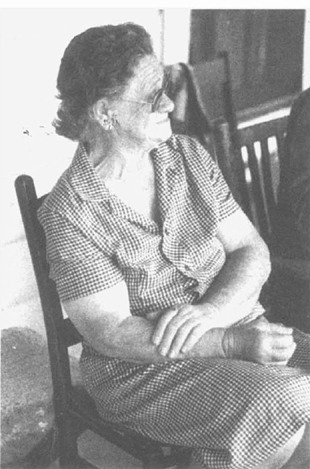
I LLUSTRATION 1 Lessie Conner
Lessie Conner remembered her familys methods for preserving fruits and vegetables. Before we bought our deep freezepeople aint had deep freezes so long, you knowin the fall of the year, wed put up a big barrel of bleached fruit, apples. (Just peel em and bleach em in sulfur.) Wed have a barrel of bleached fruit, and wed have a barrel of kraut, and thats the way we spent the winterwith stuff like that to eat.
As Mrs. Conner mentioned, one of the methods of preserving fruit was bleaching it. Several people told us that unless the fruit was prepared with too much water when it was later cooked, they could not taste the sulfur used in the process, and the bleached fruit was actually quite good. As Susie Smith said, That fruit was just as pretty and white [as it could be]. Her brother Clive Smith also remembers bleached fruits. My mother, aunts, and sisters would cut up apples to smoke them in the fall. Theyd cut em up and put em in a basket with an iron pan. Then sprinkle a little sulfur in it to preserve the apples. Theyd store em in a churn. We had fresh fruit all winter. You dont hear of smoked fruit anymore.


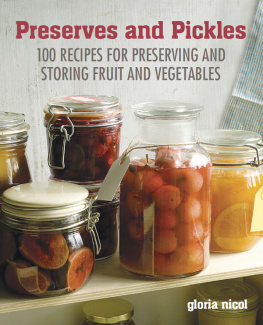

![Better Homes - Better homes and gardens you can can: [a guide to canning, preserving, and pickling]](/uploads/posts/book/188232/thumbs/better-homes-better-homes-and-gardens-you-can.jpg)
